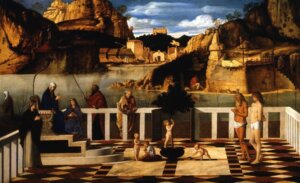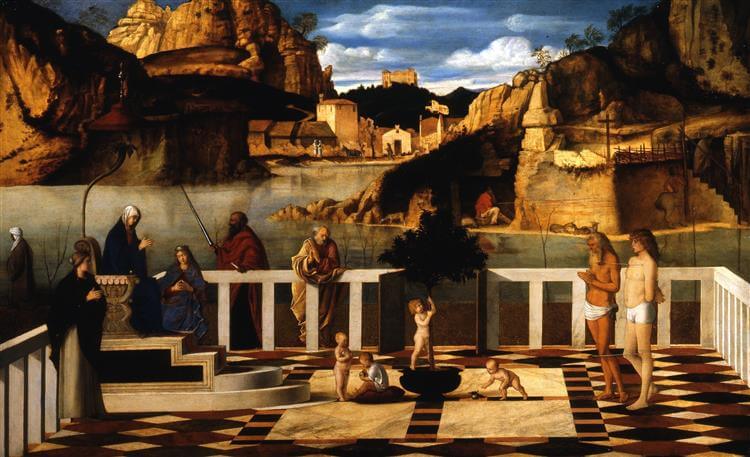
Giovanni Bellini, a key figure in the Italian Renaissance, produced numerous works that have captivated art historians and enthusiasts for centuries. Among these, the Sacred Allegory stands out not only for its artistic merit, but also for the enigmatic themes and symbols it depicts. This painting, which is housed in Florence’s Uffizi Gallery, continues to perplex scholars as to its exact meaning and the identities of the figures.
Overview and Artistic Context
The Sacred Allegory, an oil painting created between 1490 and 1500, showcases Bellini’s mature style. Bellini, who is credited with pioneering the use of oil paints in Venice, imbued his works with a luminous quality that had a significant impact on Venetian painting. The artwork depicts a complex arrangement of figures and objects within a serene, walled garden, which is frequently used to represent the Christian concept of paradise or a protected sacred realm.
Composition and Imagery
The painting is full of symbolism and meticulously detailed. It shows a group of saints and holy figures congregating around a pool, which could be interpreted as a source of divine grace or wisdom. The Virgin Mary is central to the composition, and can be assumed to be the seated woman with a child, a common representation in Christian art that suggests themes of motherhood and purity.
Surrounding her are various figures, some of whom are reading or contemplating, implying a gathering of the faithful or blessed. The presence of a bishop and a pope among the figures emphasises the work’s religious undertones. In the background, a landscape with a distant city suggests the earthly realm in contrast to the heavenly garden.
Interpretations and Theories
For years, art historians debated the specific subject matter of the Sacred Allegory. Some argue that it is an allegory of the Christian soul’s journey to salvation, with each figure representing various virtues or stages along the way. Others believe it depicts a celestial hierarchy, with the Virgin at the centre as a link between the divine and the human.
A third interpretation regards the painting as a visual representation of a religious fraternity or a gathering of saints in paradise. The inclusion of both clerical and lay figures in a peaceful garden setting could represent the universal call to holiness and the communion of saints.
Artistic Influence and Legacy.
Bellini’s work is known for its serene atmosphere and subtle interplay of colour and light, which influenced later Renaissance artists such as Titian and Giorgione. The Sacred Allegory demonstrates Bellini’s ability to create a meditative space in which the viewer can contemplate and interpret the divine mysteries it may represent.
Conclusion
Giovanni Bellini’s Sacred Allegory is a mystical masterpiece that reflects the complexity and depth of religious art during the Renaissance. Its open-ended narrative and symbolic richness ensure that it continues to inspire and spark debate among art enthusiasts and scholars. As with many great works of art, the true meaning is elusive, but the beauty and spiritual depth are undeniable.























